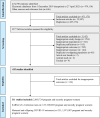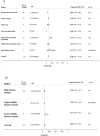Global variations in the burden of SARS-CoV-2 infection and its outcomes in pregnant women by geographical region and country's income status: a meta-analysis
- PMID: 36368768
- PMCID: PMC9659713
- DOI: 10.1136/bmjgh-2022-010060
Global variations in the burden of SARS-CoV-2 infection and its outcomes in pregnant women by geographical region and country's income status: a meta-analysis
Abstract
Introduction: The prevalence of COVID-19 and its impact varied between countries and regions. Pregnant women are at high risk of COVID-19 complications compared with non-pregnant women. The magnitude of variations, if any, in SARS-CoV-2 infection rates and its health outcomes among pregnant women by geographical regions and country's income level is not known.
Methods: We performed a random-effects meta-analysis as part of the ongoing PregCOV-19 living systematic review (December 2019 to April 2021). We included cohort studies on pregnant women with COVID-19 reporting maternal (mortality, intensive care admission and preterm birth) and offspring (mortality, stillbirth, neonatal intensive care admission) outcomes and grouped them by World Bank geographical region and income level. We reported results as proportions with 95% confidence intervals (CI).
Results: We included 311 studies (2 003 724 pregnant women, 57 countries). The rates of SARS-CoV-2 infection in pregnant women varied significantly by region (p<0.001) and income level (p<0.001), with the highest rates observed in Latin America and the Caribbean (19%, 95% CI 12% to 27%; 13 studies, 38 748 women) and lower-middle-income countries (13%, 95% CI 6% to 23%; 25 studies, 100 080 women). We found significant differences in maternal and offspring outcomes by region and income level. Lower-middle-income countries reported significantly higher rates of maternal mortality (0.68%, 95% CI 0.24% to 1.27%; 3 studies, 31 136 women), intensive care admission (4.53%, 95% CI 2.57% to 6.91%; 54 studies, 23 420 women) and stillbirths (1.09%, 95% CI 0.48% to 1.88%; 41 studies, 4724 women) than high-income countries. COVID-19 complications disproportionately affected South Asia, which had the highest maternal mortality rate (0.88%, 95% CI 0.16% to 1.95%; 17 studies, 2023 women); Latin America and the Caribbean had the highest stillbirth rates (1.97%, 95% CI 0.9% to 3.33%; 10 studies, 1750 women).
Conclusion: The rates of SARS-CoV-2 infection in pregnant women vary globally, and its health outcomes mirror the COVID-19 burden and global maternal and offspring inequalities.
Prospero registration number: CRD42020178076.
Keywords: COVID-19; Maternal health.
© Author(s) (or their employer(s)) 2022. Re-use permitted under CC BY-NC. No commercial re-use. See rights and permissions. Published by BMJ.
Conflict of interest statement
Competing interests: None declared.
Figures



References
-
- Allotey J, Stallings E, Bonet M. Clinical manifestations, risk factors, and maternal and perinatal outcomes of coronavirus disease 2019 in pregnancy: living systematic review and meta-analysis. BMJ [Internet] 2021:m3320 https://www.bmj.com/lookup/doi/ - PMC - PubMed
-
- Sakkas H, Economou V, Papadopoulou C. Zika virus infection: past and present of another emerging vector-borne disease. J Vector Borne Dis 2016;53:305–11. - PubMed
-
- Centers for Disease Control and Prevention, National Center for Emerging and Zoonotic Infectious Diseases, Division of High-Consequence Pathogens and Pathology, Viral Special Pathogens Branch . 2014-2016 Ebola outbreak distribution in West Africa 2021.
Publication types
MeSH terms
LinkOut - more resources
Full Text Sources
Medical
Miscellaneous
